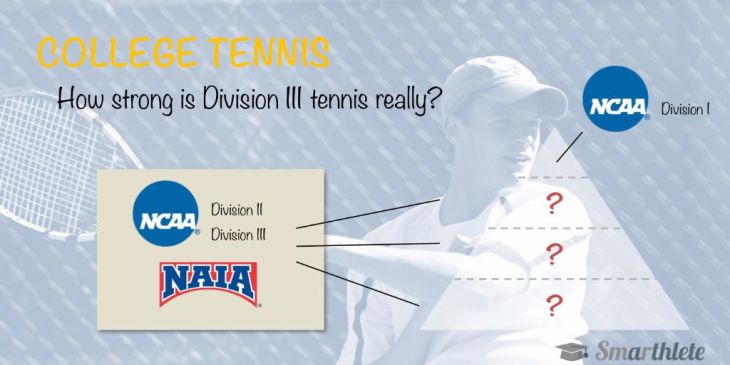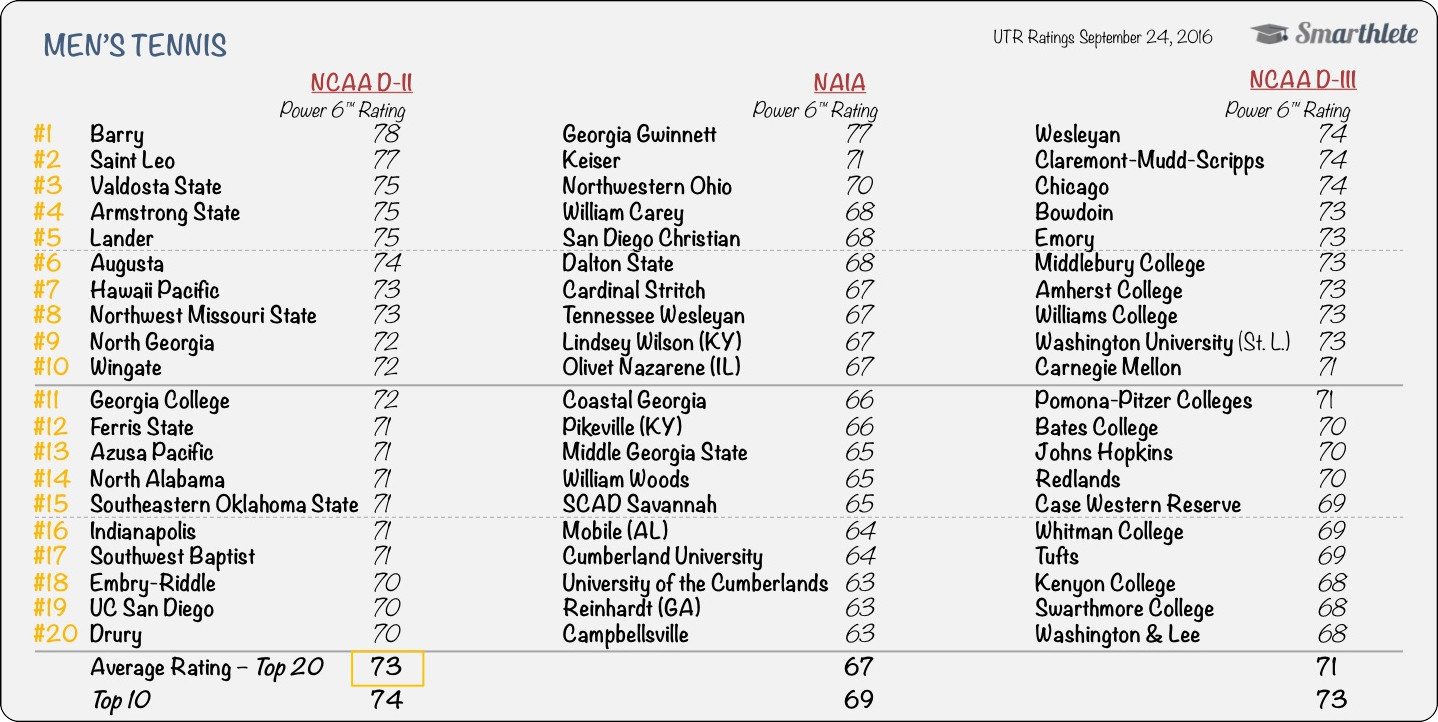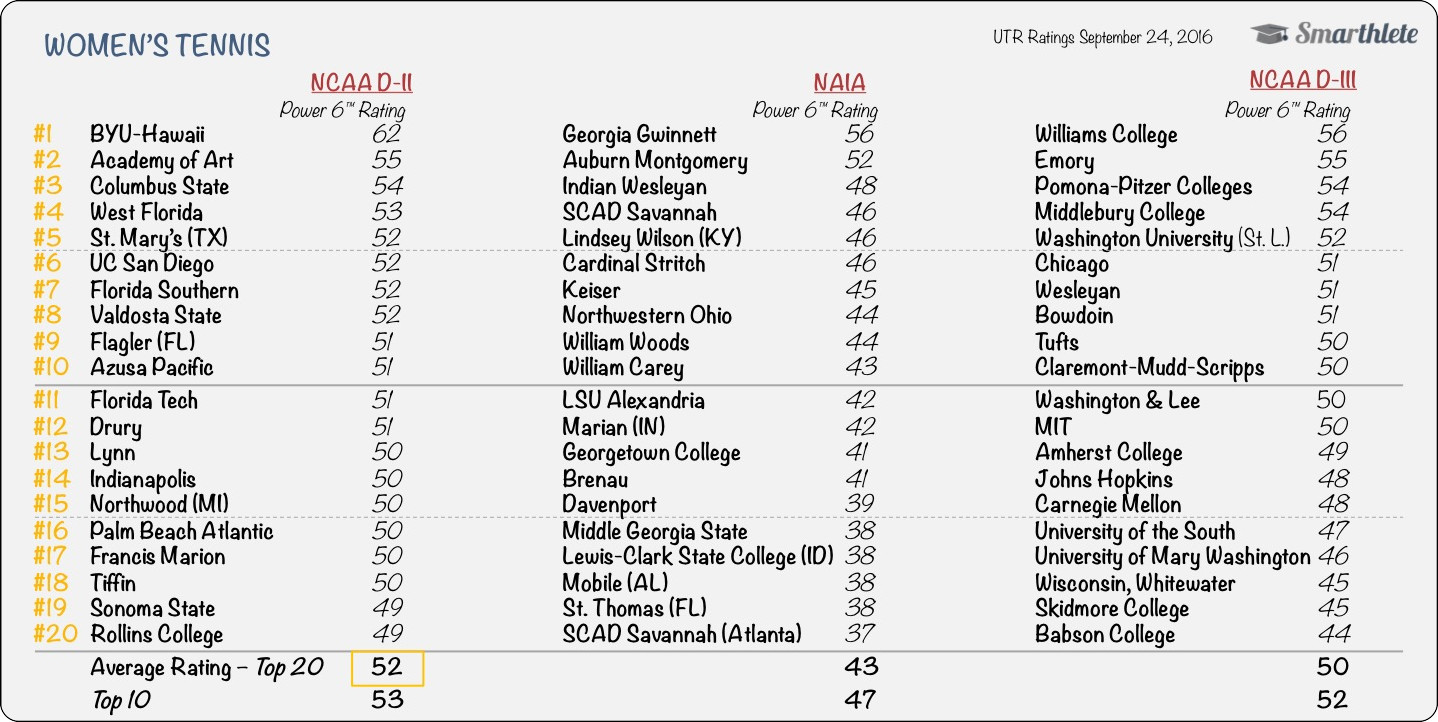How Strong is NCAA D-III Tennis Really?

Most of you are probably well aware of the main difference between NCAA Divisions and the NAIA: the lack of athletic financial aid in NCAA Division 3 schools. Take a look here if you are unsure about the maximum level of scholarship money at college.
As a result of this, the vast majority of future student-athletes seek to find a squad in any of the other main college divisions: namely in NCAA D1, NCAA D2 and within the NAIA. Especially Internationals quickly shy away from D3 programs due to the lack of funding.
But apart from the financial aspect, how does D-III tennis stack up compared to other divisions? Are players right in assuming that the non-availability of athletic scholarship money in D-III schools automatically translates into a lower level of tennis? Let's explore this common perception together:
In below two graphics we compare the top 20 teams in NCAA D-II, NAIA, and NCAA D-III, ranked by their strength according to their Universal Tennis Rating. This is different from our NCAA D2 vs NAIA analysis some weeks ago, when we took the latest ITA/NAIA rankings as starting point for the top 20 teams. But we're well into the new 2016-17 college tennis season and the latest available rankings from the last season in May/June wouldn't suffice to draw a fully correct picture at this point in time (think of graduating seniors, new incoming freshmen, and transfer students).
As in the article some weeks ago, the teams' UTR is displayed as their "UTR Power 6 Rating": the sum of the six highest-rated players in the line-up.
Please refer to the end of the article for more details about the UTR.*
Level of NCAA D-III College Tennis
Men's Tennis
The two top teams in Division 2 and the top team in the NAIA are by far the strongest with Ratings of 78 (Barry), 77 (Saint Leo) and 77 (Georgia Gwinnett). The top teams in Division 3 are Wesleyan, Claremont-Mudd-Scripps and Chicago with the same Rating of 74.
And here's where things become really interesting: While the levels drop significantly in the NAIA, the two other Divisions display much smaller a gap between the best team and the twenty best one:
- NCAA D-II: Difference between #1 Barry and #20 Drury is 8.0 rating points
- NAIA: Difference between #1 Georgia Gwinnett and #20 Campbellsville is 14.0 rating points
- NCAA D-III: Difference between #1 Wesleyan and #20 Washington & Lee is 6.0 rating points
On an aggregated level these differences are pretty compelling:
- NCAA D-II: Average Power 6 Rating of the Top 20 is 73 - average of Top 10 is 74
- NAIA: Average of Top 20 is 67 - average of Top 10 is 69
- NCAA D-III: Average of Top 20 is 71 - average of Top 10 is 73
Put differently, the male average Top 20 player in a D-III team has a UTR of 11.9 (UTR Power 6 Rating of 71/6) compared to the average D-II player's UTR of 12.1 and that of an NAIA player of 11.1.

Women's Tennis
We also benchmarked the best 20 teams of all 3 divisions measured against each other by their Power 6 Rating.
The conclusion right at the beginning: The comparison shows the exact same picture on the women's side.
Division 2 leader BYU-Hawaii is a clear outlier with a Rating of 62! Georgia Gwinnett and Williams College are trailing behind with 56 respectively. Again, the levels drop at a faster rate in the NAIA than in the NCAA:
- NCAA D-II: Difference between #1 BYU-Hawaii and #20 Rollins College is 13.0 rating points (6.0 only, if you exclude the outlier BYU)
- NAIA: Difference between #1 Georgia Gwinnett and #20 SCAD Savannah is 19.0 rating points
- NCAA D-III: Difference between #1 Williams College and #20 Babson College is 12.0 rating points
The average teams' Ratings reveal the same pattern as on the men's side. While Division III is almost level with Division II tennis, the NAIA clearly lags one step behind:
- NCAA D-II: Average Power 6 Rating of the Top 20 is 52 - average of Top 10 is 53
- NAIA: Average of Top 20 is 43 - average of Top 10 is 47
- NCAA D-III: Average of Top 20 is 50 - average of Top 10 is 52
Broken down on an individual player's level, the average Top 20 female in Division III has a UTR of 8.3 (Power 6 Rating of 50/6) compared to a UTR of 7.2 in the NAIA and a UTR of 8.6 in the Division II.

By comparing the top 20 teams in 3 college divisions as parameters for the overall strength of the respective division, we can conclude that NCAA Division III is what the name already tells us: the third-strongest college tennis league. While the NAIA does offer obvious advantages to its student-athletes, the level of tennis is the weakest of all small college divisions.
Tennis Recruiting Implications
What does that mean for you as a student-athlete? First and foremost it means that you should be open-minded about the division you are aiming at. But you should also keep the following in mind:
- Don't limit yourself to a specific Division only!
- The levels of the teams vary significantly within the divisions and it strongly depends on how strong or weak a team you get an offer from before you can make a justified decision.
- While there are no athletic scholarships in D-III, understand that there is academic scholarship money available!
- Some of the best colleges academically are D-III colleges, which explains why many students choose D-III colleges over D-I, D-II, or NAIA schools.
- Even college tennis in a D-III squad can be a stepping stone into the pro circuit, as Eric Butorac has proven impressively. After his time at Gustavus Adolphus he became a world class doubles specialist and President of the ATP Player Council.
Ready to get your recruiting process started as well? Kick it off for real by getting your personal UTR on Universal Tennis, register with your free recruiting profile here on Smarthlete, and get in touch with college coaches directly on Smarthlete right away!
*Universal Tennis calculates a dynamic Rating for all players who play matches which feed into the UTR database, such as international events and college tennis events. The teams' players individual UTRs form the basis for the Power 6 Rating of the various college teams. For more information on the UTR please refer to the company's terminology.
NCAA is a trademark of the National Collegiate Athletic Association.